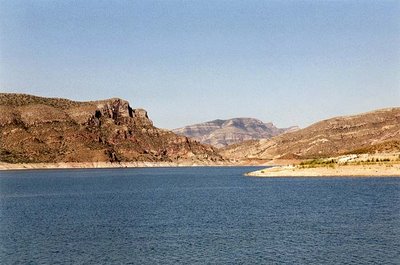Near San Carlos Lake

I thought long and hard about which way to turn, and decided to stay on a southerly route, so I turned off to the right and I'm now heading in the direction of El Paso.
I'm now a little ways northeast of San Carlos Lake, one of eight lakes with desert surroundings created by damming rivers in the hills around Phoenix, and like the others it has quite a dramatic setting with the deep blue waters framed by gaunt, rocky, cactus-speckled mountains - in this case, the foothills of the Gila, Mescal and Santa Teresa ranges. The lake was formed by the Coolidge Dam (named after the 29th president) on the Gila River - the largest in south Arizona, this has its source in the Mogollon Mountains of west central New Mexico and once over the state border flows through a wide valley for over 80 miles. It then enters a much deeper canyon through the Mescal Mountains, the penultimate series of hills before the deserts of the southwest begin, hence the mouth of this ravine was selected as the site of the dam, which was completed in 1930.
Much of the land bordering the north and east shores is dusty, featureless and rather flat - gently undulating mounds with palo verde trees, assorted bushes and scattered, often somewhat unhealthy-looking saguaro, amongst which run numerous dry sandy washes.







